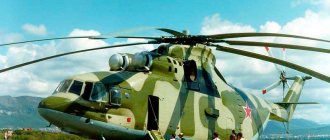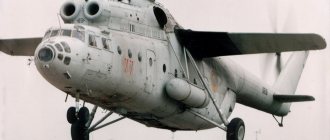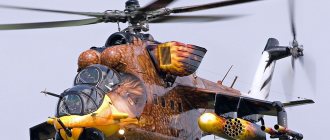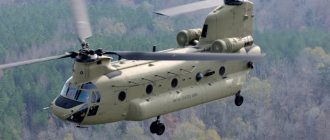The Tu-114 aircraft was created on the basis of the Tu-95 bomber. In NATO it is codenamed "Clamp". Tu-114 is a passenger aircraft developed in the Soviet Union back in 1955 and designed for long distances. The deadlines were tight: an economical, reliable, spacious and powerful aircraft was needed for long-distance flights, with a minimum number of tests.
Its production lasted 4 years, and three dozen copies were created at the Kuibyshev Aviation Plant No. 18. Speed and convenience - all this should be available to any Soviet person; this was precisely the slogan in Khrushchev’s “thaw”.
The country's jet aviation, aimed at the civilian sector, actively attracted global attention. This is what contributed to the establishment of numerous transcontinental communications.
History of the aircraft
Despite the fact that there were jet aircraft already in the 50s, the Soviet Union decided to develop a high-speed turboprop with a capacity. The task was assigned to the constant pioneers of that time, the special design bureau of A.N. Tupolev, and N.I. was appointed lead designer. Bazenkov. Tupolev, having behind him successful experience in converting aircraft from military to civilian, immediately identified the prototype of the future aircraft - it became the Tu-95.
Now there is a lot of discussion on the topic, “oh, everything had to be done from scratch, why use a military aircraft as a basis.” But then no one had experience in civil aviation with gas turbine engines. There were no norms, criteria, practices, what to tackle first?
If we take a new project and start it from scratch, it would not be possible to meet the deadlines in a short time; a lot of checks, test flights, modifications, correction of a number of problems, and the emergence of new tasks in connection with this are needed. Therefore, Tupolev chose something that had been proven over the years, especially since at that time only the military had such engines and jet speeds.
What would seem simpler? There was a military plane, cut windows in it, enlarge the fuselage, add seats, and here it is - a frightening giant of aviation! But no, it's not that simple.
As the history of this aircraft tells, problems began almost immediately, at the development stage. The largest passenger airliner of that time was supposed to be a low-wing aircraft, which is why the developers raised the height of the landing gear, and, accordingly, it became taller than other aircraft. This only added to the problems when using the aircraft. Photo of Tu-114
There were other tasks, one of which was ventilation. How will a huge number of people feel if they are placed not in the widest pipe for several hours under different conditions, at an altitude of eleven kilometers?! This is not an Airbus yet, but the first attempt to create something similar. Strength, tightness, and noise suppression from powerful engines are required. Tupolev successfully resolved these issues. True, besides the noise, there was less of it, but it was still quite loud.
In November 1957, the first test flight took place under the guidance of test pilot A.P. Yakimova. Further tests were piloted by Sukhomlin and Vedernikov. For almost 10 years, this airliner held the record as the largest passenger aircraft.
u-114 at the 1961 Paris Air Show
Modification projects
- Il-114P is a patrol version, designed to protect the maritime zone and territorial waters. The layout includes the Strizh radio-electronic complex. The magnetometer fairing is located in the tail section. The maximum flight duration is 10 hours.
- Il-114M, compared to the basic version, has an increased take-off base.
- Il-114MA is a modification of the Il-114M with Canadian Pratt-Wethney engines, allowing it to carry 74 passengers.
- Il-114 MP is a maritime patrol version of the aircraft, the purpose of which is to counter ships and submarines.
- IL-114 FC is designed for military reconnaissance and terrain mapping.
- Il-114PR is a variant intended for electronic reconnaissance.
- Il-140 is an aircraft for monitoring the tactical air situation.
- Il-140M is a special modification designed for sea rescue operations and environmental monitoring.
Application of an airplane
- 1958 A year later, the first demonstration flight to New York took place.
- In 1959 there were two non-commercial flights - from the capital to Khabarovsk and back, as well as to the West to the States with the Khrushchev delegation. A funny moment is connected with this, it was then that N. Khrushchev first flew over the Atlantic Ocean. And he did not forgive the developers for the fact that in Washington there was no high ladder for the plane - they were given an ordinary staircase, along which all important representatives of the state had to go down.
- 1961 And only two years later, in April, a regular flight to Khabarovsk appeared.
- Summer 1962. The first flight to Havana was made through Conakry, there was refueling. But the States, after the 4th voyage, opposed this turn and influenced Guinea. Access was blocked. Next, a flight with refueling in Senegal. Again 4 flights and again the States contributed to the closure of this “route”. The same thing happened with Algeria. The solution was the Murmansk region, where at the beginning of 1963 the USSR decided to refuel at a military airfield in the city of Olenegorsk. The obligations to Cuba were fulfilled.
- April 17, 1967 first flight to Japan. The ship's cabin was redesigned to separate classes - first class and economy class.
- A little later, domestic flights were made to Novosibirsk, Alma-Ata, Tashkent and Khabarovsk.
Records of the Tu-114 turboprop passenger aircraft (TPP)
Thirty-two world records belong to this Soviet-era mastodon.
- the fastest and largest TPS on earth - the best Tu-114 aircraft;
- the only TPS on earth with a swept wing;
- TPS with the most powerful turboprop engines (TPE) and the highest total power of the TPE, on one aircraft.
A photo of the Tu-114 interior is presented below. It will allow you to imagine what the plane looks like from the inside.
Design
The cockpit had branded steering wheels with the “Tu” monogram. Visibility from the cockpit is difficult by design, so on the ground the commander relied on the navigator's instructions. The 4-engine Tu-114 is a low-wing turboprop NK-12MB. It has a controlled stabilizer, swept wing and single-fin tail.
The total power of the theater is 60,000 l/s, fuel consumption in the first hour is 7.2 tons and 5.5 tons in subsequent hours. This power is enough to continue a safe flight if one of the engines fails. There was even a case when, when one of the engines failed, the second engine was turned off due to the fault of the flight engineer, and still there was enough power - thanks to the composure of commander D.I. Kukharenko managed to land the plane. Or, for example, H.N. Tskhovrebov flew on three engines across the Himalayas. The plane was as safe as possible.
Inside, the plane was more like an ocean liner - there was comfort in everything. Two decks with a common staircase are located in the fuselage. The double-deck system later became the basis for the design of modern Airbuses. But let's return to the Tu-114. On the upper deck there is a passenger salon, and on the lower deck there was a rest room for staff, two luggage compartments and a kitchen. At the very beginning of the operation of these aircraft and until the 60s, there was a private chef on board.
Tu-114 control cabin
The passenger compartment had 3 salons and 4 compartments. The latter had three sleeping places and were provided with pillows, blankets and sheets. The first two salons were seated and had 41 and 48 seats. Immediately after them there was a buffet. They served boiled eggs, cheeses, red and black caviar, smoked sausage and red fish as appetizers, as well as milk and cookies for children. For main course, roast beef with rice, poultry or meat of your choice. There were no carts on the planes; serving took place on the lower deck, was delivered via elevator to the upper deck and carried out by hand.
Performance characteristics
| Parameter | Tu-114 | IL-62 | Douglas DC-8-32 | Boeing 707-120 |
| Fuselage length, mm | 53 000 | 49 000 | — | — |
| Aircraft length, mm | 54 100 | 53 120 | 45 870 | 44 070 |
| Height, mm | 15 500 | 12 350 | 13 210 | 12 930 |
| Wingspan, mm | 51 100 | 43 200 | 43 410 | 39 900 |
| Maximum fuselage diameter, mm | 4 200 | n.d. | 3 730 | n.d. |
| Screw diameter, mm | 5 600 | absent | ||
| Empty weight, kg | 93 500 | 70 400 | 60 800 | 55 580 |
| Take-off weight, kg | 179 000 | 161 600 | 140 600 | 116 570 |
| Maximum speed, km/h | 894 | 870 | — | — |
| Cruising speed, km/h | 770 | 850 | 946 | 917 |
| Ceiling, m | 12 000 | 12 200 | ||
Flight data
There are only three Tu-114s left in the world, and all of them are museum exhibits:
- One is kept in the Civil Aviation Museum of the city of Ulyanovsk, along with its “brother”, the Tu-116, which is also a modification of the Tu-95.
- The second is located in the Central Museum of the Russian Air Force, in the Moscow region. It is there that the very first prototype is stored.
- In Ukraine, in Krivoy Rog, a third aircraft is awaiting transportation, which should be sent to the State Aviation Museum of Kyiv.
- Two more copies were destroyed 12 years ago. Both due to the renovation of Domodedovo and Vnukovo airports. The owner of Domodedovo Airport promised to preserve the monument of the era, but as it turned out in reality, these were just words so that the public would not make noise. At Vnukovo, the Tu-114 served as a training “guide” for civil defense.
Tu-114 at the Monino Museum in the original factory livery
Options [edit]
- Tu-114
- initial production version - Tu-114 6NK-8
is a projected long-range version with six NK-8 turbofan engines. Intended as an alternative to the Il-62M; never made it to production. - Tu-114-200
- modernized to the original Tu-114,
designed
for 200 passengers. Almost all aircraft were converted. - Tu-114A
- projected modernized version, designed in 1962-1963, with 98-102 passengers on long-haul flights; never produced - Tu-114B
is a radome version of the Tu-114A designed to carry a large cruise missile. - Tu-114S
- a variant of the Tu-114A with a fairing from the Tu-114B and on-board blisters - Tu-114D
- (
Dalniy
, "long-range") long-range version for flights to Cuba, with fewer passengers and an increase in take-off weight to 182,000 kg.
Three built; two were converted to Tu-114-200 standard in 1969-1970 and one was scrapped in 1962[ edit
] Not to be confused with the Tu-116 (Tu-114D). - Tu-114E
- reconnaissance version of the Tu-114A - Tu-114F
- reconnaissance version of Tu-114A and Tu-114E with additional sensors - The Tu-114PLO
is a projected naval strike variant armed with anti-ship missiles and a naval radar. This version was supposed to be equipped with a nuclear power plant. - Tu-114T
and
Tu-114TS
- conversion to air ambulance - Tu-115
- projected military transport version; never made it to production
Related events[edit]
Tu-116 [edit]
Main article: Tupolev Tu-116
The Tu-116 was a Tupolev Tu-95 bomber with pressurized passenger cabins, intended for use as official government transport. The two passenger cabins were located in the bomb bay space and were not connected to each other or to the flight deck.
Tu-126 [edit]
Main article: Tupolev Tu-126
Tu-126 (NATO classification " Moss"
) was used by the Soviet Air Force as an airborne early warning (AWACS) until it was replaced by the Beriev A-50.
Disaster in 1966
Tu-114 planes have never crashed; the only accident occurred at Sheremetyevo, due to the wrong decision of the crew commander during a night takeoff on a poorly cleared runway during snowfall. This happened on February 17, 1966.
Typical Soviet situation. The plane was supposed to fly to Africa, but for several days in a row the weather was not favorable for this - the snowstorms did not stop, the fog did not contribute to good visibility, snow bridges formed on the sides of the runway, covering the take-off lights.
During takeoff, the plane caught on the parapet, which caused it to be pulled in the opposite direction, the nose tilted, the crew of the airliner tilted the ship and it caught on the ground with its propellers, fell and burned. Twenty-one people died, few managed to survive, mostly those who were in the tail of the plane survived.
Notes
- ↑
Arsenyev, 2000. - ↑
[russianplanes.net/planelist/Tupolev/Tu-114/116/126 russianplanes.net our aviation] - ↑ 12
Magazine "Aviation and Cosmonautics", 1999 No. 04, p. 44. - ↑
Magazine "Aviation and Cosmonautics", 1999 No. 04, p. 44.45. - ↑
Magazine “Wings of the Motherland”, 1994 No. 08, p. 2. - ↑
Magazine "Aviation and Cosmonautics", 1995 No. 06, p. 45. - ↑ 12
Magazine "Aviation and Cosmonautics", 1999 No. 04, p. 45. - ↑
Magazine "Aviation and Cosmonautics", 1995 No. 10, p. 24. - ↑
“Album of layouts of passenger seats on civil aviation aircraft.” Editorial and Publishing Department of the USSR Moscow State University, 1965 - ↑
Kerber L.L., “Tupolev” - St. Petersburg: Politekhnika, 1999 - ↑
[skorobutov.wordpress.com/2013/05/17/%d0%b8%d1%81%d1%82%d0%be%d1%80%d0%b8%d1%8f-%d0%b0%d1%8d %d1%80%d0%be%d1%84%d0%bb%d0%be%d1%82%d0%b0-%d1%87%d0%b0%d1%81%d1%82%d1%8c- i-1923-1953/ History of Aeroflot: Part 2. 1953-1963] - ↑
[russianplanes.net/id85790 russianplanes.net our aviation] - ↑
[russianplanes.net/id89758 russianplanes.net our aviation] - ↑ 1 2
[www.kp.ru/daily/23749/55783/ Domodedovo Tu-114 was sent on its last flight].
// “Komsomolskaya Pravda”
(02.08.2006). Retrieved June 23, 2009. [www.webcitation.org/65UmbSftk Archived from the original on February 16, 2012]. - ↑
[russianplanes.net/reginfo/354 Tu-114 CCCP-76491] - ↑ 1234
, With. 46.











